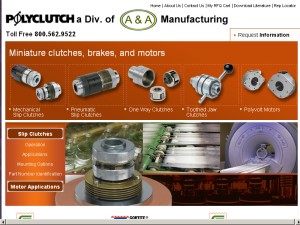Polyclutch Div. of A&A Manufacturing Co Inc
Polyclutch Div. of A&A Manufacturing Co Inc
(Formerly Custom Products Corporation)
457 State Street
North Haven, CT 06473
(Formerly Custom Products Corporation)
457 State Street
North Haven, CT 06473
Toll Free Number: (800) 562-9522
Phone Number: (262) 786-1500
Fax Number: (203) 288-5325
Web Address: www.polyclutch.com
Phone Number: (262) 786-1500
Fax Number: (203) 288-5325
Web Address: www.polyclutch.com
Categories: Clutches, Clutches, Except Vehicular, Clutches Manufacturers, Mechanical Power Trans Equip Nec (mfrs)
Miniature clutches, brakes, and motors.
Polyclutch slip clutches can slip continuously or intermittently for over 30 million cycles. This opens up many design engineering options including:
Tension Control
Maintain constant tension while winding or unwinding wire, paper, film, thread, etc. Slipclutch automatically compensates for changes in speed and diameter. Pneumatic clutch can change tension during operation.
Torque Control
Screw bottle caps, screws, controls, etc. to the correct torque setting. Combine with one way clutch to slip at rated torque in one direction and freewheel or positive drive in other direction.
Overload Protection
Protect machinery and operator. Clutch will slip when mechanism is jammed. Motion will continue when impediment is removed.
Indexing
Hold index wheel with solenoid operated pin. Motor runs continuously with clutch slipping. Pin pulls back to index to next station. Can be single or partial revolution. Can index tables, conveyors, vending machines, controls, etc.
Force Control
Push product against gate with constant force. Remote gate and move to next position. No damage to product or conveyor - clutch does all the slipping. Also used for overload protection when jammed and for indexing the conveyor.
Position Retention Hinge
Hold lid, cover, door, screen, etc. at any position. Fingertip control. Combine with one way clutch for free movement in one direction.
Soft Starts/Cushioned Stops
Inertia makes clutch slip when starting and/or stopping. Results in less shock throughout the system. Ideal for slip at the end of stroke.
Keywords: clutch, slip clutch, mechanical slip clutch, pneumatic slip clutch, torque control, overload protection
Polyclutch slip clutches can slip continuously or intermittently for over 30 million cycles. This opens up many design engineering options including:
Tension Control
Maintain constant tension while winding or unwinding wire, paper, film, thread, etc. Slipclutch automatically compensates for changes in speed and diameter. Pneumatic clutch can change tension during operation.
Torque Control
Screw bottle caps, screws, controls, etc. to the correct torque setting. Combine with one way clutch to slip at rated torque in one direction and freewheel or positive drive in other direction.
Overload Protection
Protect machinery and operator. Clutch will slip when mechanism is jammed. Motion will continue when impediment is removed.
Indexing
Hold index wheel with solenoid operated pin. Motor runs continuously with clutch slipping. Pin pulls back to index to next station. Can be single or partial revolution. Can index tables, conveyors, vending machines, controls, etc.
Force Control
Push product against gate with constant force. Remote gate and move to next position. No damage to product or conveyor - clutch does all the slipping. Also used for overload protection when jammed and for indexing the conveyor.
Position Retention Hinge
Hold lid, cover, door, screen, etc. at any position. Fingertip control. Combine with one way clutch for free movement in one direction.
Soft Starts/Cushioned Stops
Inertia makes clutch slip when starting and/or stopping. Results in less shock throughout the system. Ideal for slip at the end of stroke.
Keywords: clutch, slip clutch, mechanical slip clutch, pneumatic slip clutch, torque control, overload protection
Customer Reviews for Polyclutch Div. of A&A Manufacturing Co Inc
Be the first to review Polyclutch Div. of A&A Manufacturing Co Inc - Use the thumbs to get started!
Polyclutch Div. of A&A Manufacturing Co Inc has not yet completed their interview.
- ©2025 NewHavenCountyCTBusinessList.com
- Privacy Policy
- FAQ
- Contact
This site has been visited 4,345 times

